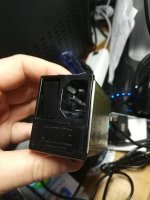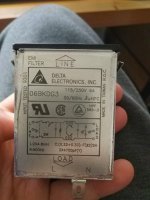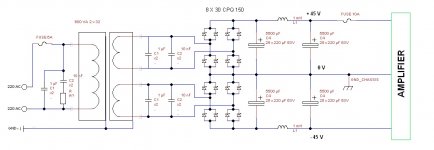read up on snubbers. there are some excellent Threads on this Forum describing snubbers, how to size them and where to place them.C2 is a Wima mp3 x2 10nF 250V. What R should I add?
A filter requires an impedance in the line and another low impedance in the route that takes the interference signal to some harmless node. If you catch that interference AFTER it enters the enclosure, then all the wiring carrying that interference emits emi. You should be locating the filter/s near the sources. For mains interference that means the filters should be at the enclosure entry point. For internally generated interference, the filters should be at the interference generator.Will place that filter on the mains side. Will there be any real benefit from placing the filter on both side of the Transformer?
No!Also if I place that on e mains side should I rather use a 400v cap or 250 will be sufficient. I have an average of 230 in my mains.............
You must use a mains rated interference filter, or use components that are mains rated and fit them inside a steel/copper can that is electrically attached to the enclosure, via an ultra low impedance connection.
Last edited:
If it is X rated for your mains you do not need to worry about its DC voltage rating.idir said:Also if I place that on e mains side should I rather use a 400v cap or 250 will be sufficient. I have an average of 230 in my mains.
SO when it comes to EMI filtering, do you think I should use a filter I already own, the one in the pictures (I think it is is a CRLC), or making a RC Snubber by myself?


Using this filter will make me connect earth and ground, a connection I want to avoid, as i have 2 screens in my transformer that I will connect to earth and keep ground within the box.


Using this filter will make me connect earth and ground, a connection I want to avoid, as i have 2 screens in my transformer that I will connect to earth and keep ground within the box.
Last edited:
your IEC socket +Fuse +Filter is rated for 6A.
That is quite high.
You can use this and insert a lower fuse.
High current filters do not give as much attenuation of RF as do low current filters.
If you want maximum RF attenuation choose a lower current rating.
I have 1A, 3A and 6A versions. For most of my equipment I use the 1A, or 3A depending on the transformer VA.
The can of the filter needs to be in electrical contact with the enclosure for best attenuation of interference.
You can add extra RF filtering after the can. But you must use mains rated components.
That is quite high.
You can use this and insert a lower fuse.
High current filters do not give as much attenuation of RF as do low current filters.
If you want maximum RF attenuation choose a lower current rating.
I have 1A, 3A and 6A versions. For most of my equipment I use the 1A, or 3A depending on the transformer VA.
The can of the filter needs to be in electrical contact with the enclosure for best attenuation of interference.
You can add extra RF filtering after the can. But you must use mains rated components.
remove the primary capacitor and snubber.after some corrections.
View attachment 599050
remove the secondary C2. Insert the secondary snubbers where you had C2.
If you put a coil immediately after diodes, you can use only one diode, not two parallel. Current peak will be greatly reduced and this will also help with EMI behavior .
Just noticed you have shown a 6A fuse to supply the 230Vac 600VA transformer.after some corrections.
View attachment 599050
That is a very high rating for your mains fuse.
It will pass 12A for a few (or many) minutes if you have a serious fault.
That will be a lot of fault heat !
A T2.5A fuse is big enough to supply your 600VA transformer. But to get it to start, without blowing this close rated fuse, you would need to add a soft start circuit. The added resistance for the soft start would be around 40r to 50r.
If you put a coil immediately after diodes, you can use only one diode, not two parallel. Current peak will be greatly reduced and this will also help with EMI behavior .
this is 30CPQ150 in TO246 common cathode Schottky diode, cannot use just one...
Just noticed you have shown a 6A fuse to supply the 230Vac 600VA transformer.
That is a very high rating for your mains fuse.
It will pass 12A for a few (or many) minutes if you have a serious fault.
That will be a lot of fault heat !
A T2.5A fuse is big enough to supply your 600VA transformer. But to get it to start, without blowing this close rated fuse, you would need to add a soft start circuit. The added resistance for the soft start would be around 40r to 50r.
Andrew just mounted the soft start and a 2.5 A fuse, tested with a 60W bulb as load, and the fuse is just fine.
Thanks!
In this case you can use a smaller package with only one diode.
To save space you can put diodes under the coils.
To save space you can put diodes under the coils.
the bulb is acting as a severe current limiter.this is 30CPQ150 in TO246 common cathode Schottky diode, cannot use just one...
Andrew just mounted the soft start and a 2.5 A fuse, tested with a 60W bulb as load, and the fuse is just fine.
Thanks!
You would need to do a final cold start after completing the build and repeat that a few times before you can confirm that the T2.5A fuse gives reliable cold start and allows very loud music/audio when you host a party.
- Status
- Not open for further replies.
- Home
- Amplifiers
- Power Supplies
- Power supplies differences
